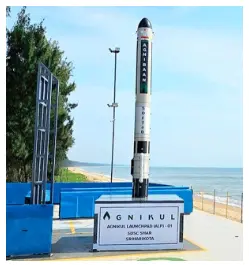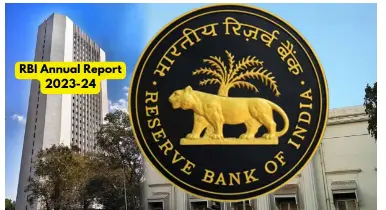Tuesday, 4th June 2024
KAZA Summit 2024
In the News:
- At the KAZA Summit 2024, the leaders of the Kavango-Zambezi Trans-Frontier Conservation Area (KAZA-TFCA) resolved to oppose the ivory trade ban at the CoP 20 of CITES.
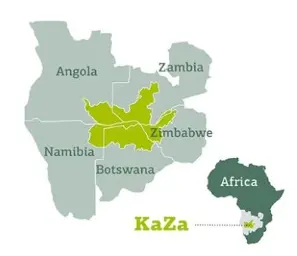
About the KAZA Summit:
- Evaluate the advancements in establishing and developing the Kavango-Zambezi Trans-Frontier Conservation Area (KAZA-TFCA) since its inception.
- Examine the progress of the 2016 Memorandum of Understanding and the implementation of the 2011 KAZA Treaty.
- Seek renewed commitment from current leaders of the member countries.
Theme of the Summit:
- “Leveraging KAZA’s natural capital and cultural heritage resources as catalysts for inclusive socio-economic development of the ecoregion.”
Kavango-Zambezi Trans-Frontier Conservation Area (KAZA-TFCA):
- The Kavango-Zambezi Trans-Frontier Conservation Area (KAZA-TFCA) spans 520,000 square kilometres, covering parts of five southern African nations: Angola, Botswana, Namibia, Zambia, and Zimbabwe.
- Centred around the Okavango and Zambezi river basins, KAZA-TFCA boasts a significant elephant population, representing over two-thirds of Africa’s total, estimated at around 450,000.
- Botswana hosts the largest number of elephants within the region (132,000), followed by Zimbabwe with 100,000 elephants.
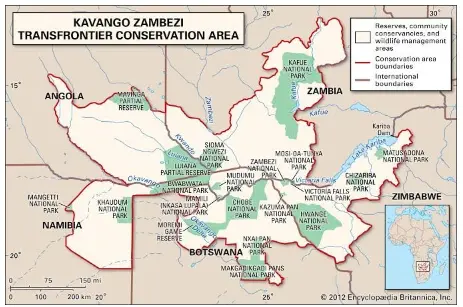
|
About CITES:
Key Features:
Appendices of CITES:
Conference of the Parties (CoP):
|
Ivory Trade:
- The ivory trade refers to the commercial exchange of elephant ivory tusks and other ivory products.
- Key Facts:
- Illegal Killing: Each year, at least 20,000 African elephants are illegally killed for their tusks.
- Threats to Survival: The ivory trade endangers elephant populations, harms ecosystems, jeopardises local communities, and undermines security.
- Trade Dynamics:
- Smuggling Routes: Traditionally, the ivory trade has involved smuggling whole or partial elephant tusks from Africa to Asia.
- Processing: In Asia, particularly China, tusks are processed and carved into ivory products.
- Demand: The demand is driven by a growing middle class in China, where ivory carving is a long-standing tradition
Reasons Behind Advocating for Trade Ban Lift:
- Southern African leaders are advocating for the lifting of the CITES ivory ban, citing economic benefits.
- They point to the substantial value of the ivory stockpile held by KAZA states, estimated at $1 billion. For instance, Zimbabwe's stash, totaling 166 tons, is valued at $600 million.
Issues:
- During the 19th CITES conference in Panama in 2022, KAZA states and five other southern African nations pushed for the resumption of ivory and elephant product trade.
- Southern African countries, including those in the KAZA region, argue that their large elephant populations contribute to habitat loss and human-wildlife conflict.
- Despite persistent appeals, CITES delegates rejected the proposal, sparking frustration among African nations.
- Ten countries, including KAZA states and others like Eswatini, Lesotho, Mozambique, South Africa, and Tanzania, lodged a dispute with CITES. They criticised the organisation for deviating from its core principles and prioritising ideologies over science-based conservation approaches.
Way forward:
- Lobbying for Change: Advocate for a fairer and science-driven approach to wildlife trade regulations within global frameworks like CITES.
- Regional Cooperation: Strengthen collaboration among member states to devise collective conservation strategies and exchange successful methods for addressing human-wildlife conflicts.
- Diversification of Revenue Streams: Investigate alternative funding avenues for conservation initiatives, including ecotourism, carbon credits, and sustainable farming practices.
Source: DTE
Bellied Eagle Owl
In the News:
- Recently, Pench Tiger Reserve (PTR), Maharashtra, reported the first photographic record of a spot-bellied eagle owl.
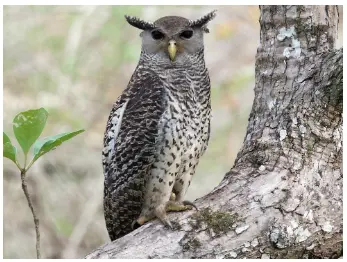
About Spot Bellied Eagle Owl:
- Also known as the forest eagle-owl, this bird of prey boasts a formidable appearance.
- Scientific Name: Ketupa nipalensis
- Distribution:
- It inhabits diverse habitats, including tropical and subtropical forests, woodlands, and savannas.
- Found commonly in India, Sri Lanka, Nepal, Bhutan, Bangladesh, and parts of Southeast Asia.
Features:
- A large owl species, measuring 50 to 65 cm in length and weighing 1500 to 1700 grams With a wingspan of up to 1.7 metres.
- Distinguished by its striking coloration, featuring rich chocolate brown upperparts speckled with white spots.
- Wings and tail feathers are barred with alternating shades of brown and white, aiding in camouflage.
- Named for its light cream-coloured belly and breast adorned with bold black spots.
- Primarily nocturnal.
- An apex predator, preying on rodents, small mammals, reptiles, and insects.
- Solitary and territorial, maintaining a defined home range.
Conservation Status:
- IUCN Status: Least Concern
- Wildlife (Protection) Act, 1972: Schedule IV
- CITES: Appendix II.
Source: TOI
Non-infectious Nipah virus-like particles (VLPs)
In the News:
- Recently, scientists at the Institute of Advanced Virology (IAV), Thiruvananthapuram, developed a novel way of generating non-infectious Nipah virus-like particles (VLPs) in the laboratory.
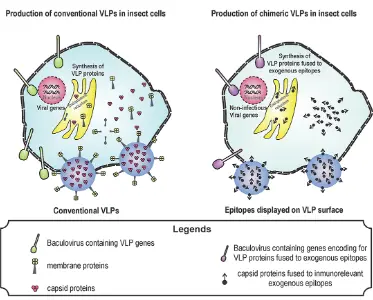
About Virus-like Particles (VLPs):
- VLPs resemble viruses but lack infectivity due to the absence of viral genetic material.
- Effective in creating vaccines against diseases like human papillomavirus (HPV), hepatitis B, and malaria.
- Trigger an immune response upon introduction into the body without causing virus symptoms.
- Once the immune response occurs, the body recognizes and prevents future infections, providing immunity.
Structure:
- Small in size, with a radius of 20 to 200 nm, allowing easy entry into lymph nodes.
- Comprise one or more structural proteins arranged in layers, sometimes with an outer lipid envelope.
- The outer layer shields the genetic material, enhancing protection.
- VLP vaccines can be produced using bacterial, yeast, insect, or mammalian cells.
- As vaccines, VLPs prompt a robust immune response due to epitope density and the presentation of multiple proteins.
- Recent advancements include using VLPs as nanomachines for targeted delivery of pharmaceuticals to specific cells in the body.
|
Key Facts about Nipah Virus:
|
Treatment:
- No specific drugs or vaccines exist for Nipah virus infection.
- Treatment primarily involves intensive supportive care to manage severe respiratory and neurological complications.
Source: TH
RBI to expand Unified Payment Interface (UPI) by 2028-29
In the news:
- In Annual Report for 2023-24, RBI, collaboration with NPCI International Payments Ltd. (NIPL) to expand Unified Payment Interface (UPI) to 20 countries by 2028-29.
- The RBI also aims to investigate potential collaborations on the Fast Payment System with regional blocs such as the European Union and SAARC, as well as explore multilateral connections.
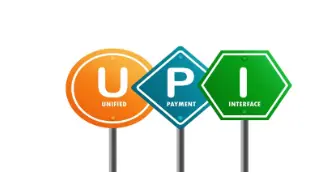
About UPI:
- UPI, introduced by NPCI in 2016, consolidates multiple bank accounts into a single mobile application, offering various banking features, smooth fund transfers, and merchant payments.
- It is now supported by numerous countries such as Bhutan, Nepal, UAE, France, Mauritius, etc., facilitating UPI payments internationally.
Significance of Internationalisation of UPI:
- Global market expansion: Enabling faster cross-border payments can boost trade between India and other nations.
- Interoperability and standardisation: Widespread UPI adoption can enhance interoperability between payment systems globally, facilitating seamless integration with financial technologies.
- Digital diplomacy: Collaborating on technological advancements enhances India's influence and fosters goodwill internationally.
Challenges in Internationalisation of UPI:
- Regulatory compliance: Adhering to diverse regulatory frameworks in multiple jurisdictions poses complex challenges.
- Security and data privacy: Implementing robust security measures and encryption protocols is crucial to maintain user trust and safeguard data.
- Other challenges: Disparities in infrastructure and competition from established players like China's Alipay add to the complexities of internationalisation.
Steps taken for the Internationalisation of UPI:
- Establishment of NIPL: NPCI's wholly-owned subsidiary, NIPL, was formed in 2020 to deploy RuPay and UPI services globally.
- UPI One World: Introducing a prepaid payment instrument linked to UPI for foreign nationals/NRIs from G20 countries.
- India's Initiatives under G20: Launching the Global Digital Public Infrastructure (DPI) Repository and a Social Impact Fund to promote DPI in the Global South.
|
UPSC Civil services examination PYQ Prelims: Q:1 With reference to Indian economy, consider the following: (2015)
Which of the above is/are components/ components of Monetary Policy? (a) 1 only (b) 2, 3 and 4 (c) 1 and 2 (d) 1, 3 and 4 Ans: (c) Q:2 Which of the following statements is/are correct regarding the Monetary Policy Committee (MPC)? (2017)
Select the correct answer using the code given below: (a) 1 only (b) 1 and 2 only (c) 3 only (d) 2 and 3 only Ans: (a) Q:3 If the RBI decides to adopt an expansionist monetary policy, which of the following would it not do? (2020)
Select the correct answer using the code given below: (a) 1 and 2 only (b) 2 only (c) 1 and 3 only (d) 1, 2 and 3 Ans: (b) Q:4 Which one of the following activities of the Reserve Bank of India is considered to be part of 'sterilisation'?(2023) a) Conducting 'Open Market Operations' b) Oversight of settlement and payment systems c) Debt and cash management for the Central and State Governments d) Regulating the functions of Non-banking Financial Institutions Answer: A |
Source: financialexpress.
Iraq (Capital: Baghdad)
In the news:
- UNSC voted to end the United Nations Assistance Mission in Iraq (UNAMI) established in 2003 following the United States-led invasion.
- UNAMI was established to coordinate post-conflict humanitarian and reconstruction efforts, and to help restore a representative government in the country.
Political Features:
- Territorial Boundaries: Turkiye (north), Iran (east), Syria and Jordan (west), Saudi Arabia and Kuwait (South)
- Maritime Boundaries: Opens into Persian Gulf
Geographical Features
- Major Mountains: Sinjar Mountains, Zagros Mountains (Northern Iraq, bordering Iran)
- Rivers: Tigris, Euphrates
- Lakes: Habbaniya, Razzaza or Lake Milh (man-made lake and it at the risk of drying up)

Source: TH
Consumption Divide Across Indian States
In news:
- Recently, Bank of Baroda has published a report about the finances of Indian states for the financial year ended March (FY2024).
- The report analyses state-level finances based on three variables: how much money they raised on their own, how much they spent to boost productive capacities of the state, and how much they borrowed from the market.
Key findings highlights:
Fiscal Deficit:
- Budgetary Discipline: Most states managed to keep their borrowing in check (fiscal deficit) as planned in their budgets.
- National Impact: This is important because excessive borrowing by states puts pressure on the central government's finances, limiting the availability of funds for private businesses.
- Loan Costs: When there's less money available for investment, interest rates rise, making it more expensive to borrow money for everything - houses, cars, and even factories.
- Strong Fiscal Management:Large states such as Gujarat, Maharashtra, Odisha, and Tamil Nadu undershot their budgeted borrowings by over 30%.
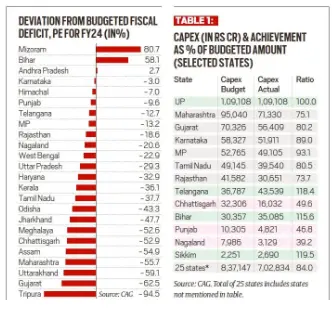
Capital Spending:
- Investments in infrastructure like roads and bridges (capex) drive economic growth within a state.
- Overall, states spent only 84% of their budgeted capex.
- Uttar Pradesh, Telangana, Bihar and Sikkim achieved or exceeded targets. - Punjab, Chhattisgarh, and Nagaland underperformed, spending less than 50% of the budget.
Tax Revenue:
- State tax revenue consists of two main parts: their own tax collections (OTR) and a share of central taxes.
- OTR accounted for around 61% of tax revenues of states. A higher OTR share indicates a state's stronger financial health.
- Within the OTR, GST (Goods and Services Tax) collections made up the biggest chunk (almost 32%), followed by state excise and sales tax (22%) and stamp and registration (7%).
- Telangana (82%) led the states in OTR share, followed by Haryana (79%), Karnataka (78%), Kerala (77%), Maharashtra (73%), and Tamil Nadu (71%).
Consumption Based Tax (GST):
- GST (Goods and Services Tax) is a consumption-based tax levied in India. This means the tax is collected at the point of final consumption of a good or service.
- The distribution of per capita GST collected across states reflects the consumption patterns within the country. States with higher consumption levels tend to pay more taxes like GST and sales tax/excise duty.
- In contrast, states with limited consumption capacity rely more heavily on transfers from central taxes, as allocated by the Finance Commission.
Consumption Divide:
- The average per capita GST collection of the 25 states considered by the researchers was Rs 7,029.
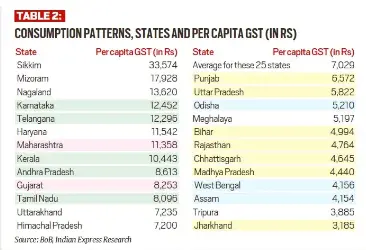
NORTH-SOUTH DIVIDE:
- States in North India (highlighted in yellow) fall well below the national average, while states in the South (highlighted in green) pull up the national average.
- Per-capita GST levels in Karnataka or Telangana are almost 3-4 times that of Madhya Pradesh and Jharkhand, which shows the relative lack of prosperity of the average citizen in the latter states.
EAST-WEST DIVIDE:
- There is a divide between some of the big states in the East and West.
- Consumption levels in Maharashtra and Gujarat (in pink) are far in excess of those in Odisha, West Bengal and Assam (in blue).
Note:
There are some exceptions — such as Haryana in the North — but a broad divide is clearly visible.
Source: IE
Pandemic Treaty
In news:
- Recently, annual meeting, the World Health Assembly (WHA) reached consensus on a critical set of amendments to the International Health Regulations (2005) (IHR).
- These amendments will strengthen global preparedness, surveillance and responses to public health emergencies, including pandemics.
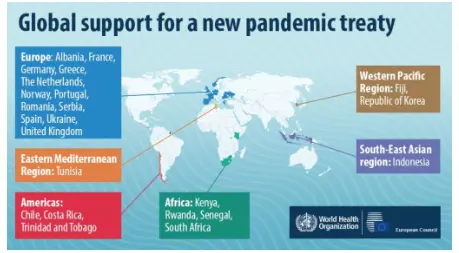
The Key Amendments Agreed to IHR:
- This encompasses the establishment of a Coordinating Financial Mechanism aimed at facilitating the identification and provision of necessary financing to tackle the requirements and focal points of developing nations.
- It entails the enhancement of core capacities and other essential capacities related to pandemic emergency prevention, preparedness, and response.
- This entails the formation of a States Parties Committee dedicated to fostering collaboration and efficient execution of the amended regulations.
- Furthermore, it involves establishing National IHR Authorities to enhance coordination in the implementation efforts both domestically and internationally.
The Need for Global Health Cooperation:
Combating Infectious Diseases:
- Timely detection and dissemination of disease outbreaks accelerate global response efforts. The World Health Organization (WHO) exemplifies this role through its identification and monitoring of Covid-19 variants.
- Collaborative endeavours expedite the development of vaccines, diagnostics, and treatments, crucial for effective pandemic management.
Tackling Antibiotic Resistance:
- The widespread misuse of antibiotics in any region can engender resistant bacteria with global repercussions. International cooperation aids in:
- Implementing universal guidelines for antibiotic usage in both humans and animals serves to mitigate resistance proliferation.
- According to the World Health Organization (WHO), antimicrobial resistance poses a significant global health menace, potentially resulting in millions of fatalities annually if not collectively addressed.
Managing Chronic Diseases:
- Non-communicable ailments like heart disease and diabetes pose escalating global challenges. Cooperative efforts contribute to knowledge dissemination, encompassing:
- Sharing insights on prevention, treatment, and lifestyle modifications enables countries to glean from each other's experiences. For instance, the Global Alliance for Chronic Diseases (GACD) exemplifies this collaborative spirit.
Promoting Health Equity and Access:
- Numerous nations grapple with resource shortages in effectively tackling health crises. Global collaboration fosters:
- Initiatives like the Medicines Patent Pool facilitate equitable access to cost-effective generic medications.
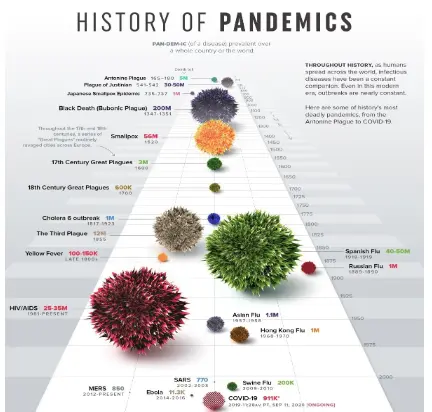
The Existing Framework for Global Health Cooperation:
- Multilateral Organisations: Various multilateral institutions such as WHO, UNICEF, UNFPA, and UNAIDS hold pivotal roles in addressing specific health domains like child health, reproductive health, and HIV/AIDS.
- It establishes international health standards, extends technical assistance to nations, and oversees and harmonises the global response to health crises.
- International Health Regulations (IHR): These regulations constitute a legally binding pact among 196 nations, delineating their rights and obligations concerning public health incidents with international ramifications.
- Global Health Initiatives: These initiatives encompass targeted programs aimed at combating specific health challenges. Notable examples include the Global Fund to Fight AIDS, Tuberculosis and Malaria, as well as Gavi, the Vaccine Alliance.
- Public-Private Partnerships: Collaborative efforts involving governments, non-governmental organisations (NGOs), and the private sector enable the pooling of resources and expertise. A prominent illustration is the Bill & Melinda Gates Foundation.
- Regional Organisations: Regional entities like the Pan American Health Organization (PAHO) for the Americas and the African Union assume roles in coordinating health endeavours within their respective regions.
Conclusion
Hence, the recent amendments to the International Health Regulations (IHR) by the World Health Assembly (WHA) and the pledge for a global pandemic agreement by 2025 mark a crucial advancement in enhancing global health security.
|
UPSC Civil Services Examination, Previous Year Questions (PYQs) Prelims Q1. With reference to agriculture in India, how can the technique of ‘genome sequencing’, often seen in the news, be used in the immediate future? (2017)
Select the correct answer using the code given below: (a) 1 only (b) 2 and 3 only (c) 1 and 3 only (d) 1, 2 and 3 Ans: (d) Q:2 With reference to recent developments regarding ‘Recombinant Vector Vaccine’, consider the following statements: (2021) 1. Genetic engineering is applied in the development of these vaccines. 2. Bacteria and viruses are used as vectors. Which of the statements given above is/are correct? (a) 1 only (b) 2 only (c) Both 1 and 2 (d) Neither 1 nor 2 Ans: (c) Mains Q:1 What are the research and developmental achievements in applied biotechnology? How will these achievements help to uplift the poorer sections of society? (2021) Q:2 What is the basic principle behind vaccine development? How do vaccines work? What approaches were adopted by the Indian vaccine manufacturers to produce COVID-19 vaccines? (2022) |
India's Leap Towards Green Energy
Context:
- India stands at a critical moment in its energy evolution, charting a substantial course towards a greener and sustainable future.
- Driven by the dual aims of diminishing reliance on imported fossil fuels and fulfilling commitments to decarbonization and sustainability, the nation is expediting its transition towards clean renewable energy sources.
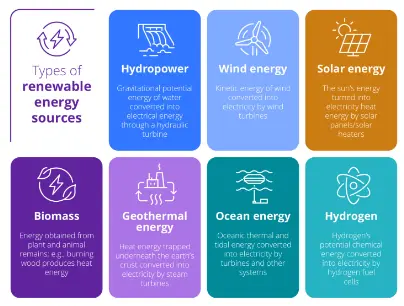
The Green Energy Transition Significant for India:
Combating Climate Change and Air Pollution:
- India, as the third-largest emitter of greenhouse gases after China and the US, faces significant environmental challenges.
- According to the 2022 State of Global Air Report, air pollution alone accounted for at least 1.6 million deaths in India in 2019.
- Adopting green energy will drastically reduce emissions and enhance air quality, leading to a healthier population.
Energy Security and Import Dependence:
- India is projected to account for 25% of global energy demand growth over the next two decades, making it vulnerable to price fluctuations and geopolitical tensions.
- For example, the Russia-Ukraine war has disrupted global energy markets, causing oil prices to spike. Green energy sources offer greater energy independence and price stability, mitigating these risks.
Attracting Investments and Global Leadership:
- The global emphasis on sustainability is drawing substantial investments into green technologies.
- By shifting to green energy, India can position itself as a leader in the clean energy sector, attracting investments and driving technological advancements.
Unlocking Opportunities in New Technologies:
- The transition to green energy enables India to develop and harness cutting-edge clean energy technologies, such as energy storage solutions and smart grids.
- This not only fosters innovation but also positions India at the forefront of the global clean energy revolution.
The Major Roadblocks in India’s Green Energy Transition:
High Dependence on Fossil Fuels:
- India's energy mix is still heavily reliant on fossil fuels, with coal accounting for around 55% of the country's electricity generation.
Vulnerability in Green Technology:
- India's dependence on imported green technology, particularly China's dominance in solar panels, wind turbines, and critical minerals, creates a vulnerability.
- Around 70% of India's solar power generation capacity is built on China-made solar equipment.
Grid Integration Challenges:
- The intermittent nature of renewable energy sources like solar and wind poses significant challenges in maintaining grid stability and ensuring a reliable and consistent power supply.
Limited Energy Storage Capacity:
- Energy storage solutions like pumped hydro and battery storage are still in their early stages in India. This limits the ability to store excess renewable energy for later use, hindering their effectiveness in meeting peak demand periods.
- India needs an advanced battery energy storage system (BESS) ecosystem to support 500GW of non-fossil energy targets by 2032.
Waste Management of Solar Panels and Wind Turbines:
- The increasing use of solar panels and wind turbines raises concerns about their end-of-life management.
- India generated about 100 kilotons (kt) of solar waste in the financial year (FY) 2022-2023 and it is expected to reach 600 kt by 2030.
Water-energy Nexus Challenges:
- The water-intensive nature of certain renewable energy technologies, such as concentrated solar power (CSP), poses challenges in water-stressed regions of India.
- The water level in the country's 150 main reservoirs has already dropped to 23% as per Central Water Board, significantly posing a challenge to the adoption of water intensive renewable energy technologies.
India can Accelerate Green Energy Transition:
- Providing seed funding, incubation support, and regulatory frameworks to empower local entrepreneurs developing innovative solutions for clean energy access in rural areas.
- Incorporating circular economy principles in the renewable energy sector by promoting the reuse, repurposing, and recycling of components and materials used in solar panels, wind turbines, and energy storage systems.
- Exploring innovative solutions like agrivoltaics, where solar panels are installed on agricultural lands, allowing for simultaneous energy production and crop cultivation.
- Establishing large-scale renewable energy storage parks, combining various storage technologies like batteries, pumped hydro, and thermal storage, to enhance grid stability and enable higher renewable energy penetration.
- Create a vibrant "Green Gig Economy" by upskilling and reskilling the existing workforce for renewable energy jobs.
- Utilising online platforms like Skill India Digital Hub (SIDH) to connect skilled individuals with freelance work in solar panel installation, wind turbine maintenance, and electric vehicle repair.
- Combining the ministries of fossil fuels and renewables into a single energy ministry will enhance coordination, integrated planning, and efficient resource allocation.
|
UPSC Civil Services Examination, Previous Year Question (PYQ) Prelims Q:1 With reference to the Indian Renewable Energy Development Agency Limited (IREDA), which of the following statements is/are correct? (2015)
Select the correct answer using the code given below: (a) 1 only (b) 2 only (c) Both 1 and 2 (d) Neither 1 nor 2 Ans: (c) Mains Q:1 “Access to affordable, reliable, sustainable and modern energy is the sine qua non to achieve Sustainable Development Goals (SDGs)”.Comment on the progress made in India in this regard. (2018) |
Source: IE
Share the article
Edukemy’s Current Affairs Quiz is published with multiple choice questions for UPSC exams
MCQ
Get Latest Updates on Offers, Event dates, and free Mentorship sessions.

Get in touch with our Expert Academic Counsellors 👋
FAQs
UPSC Daily Current Affairs focuses on learning current events on a daily basis. An aspirant needs to study regular and updated information about current events, news, and relevant topics that are important for UPSC aspirants. It covers national and international affairs, government policies, socio-economic issues, science and technology advancements, and more.
UPSC Daily Current Affairs provides aspirants with a concise and comprehensive overview of the latest happenings and developments across various fields. It helps aspirants stay updated with current affairs and provides them with valuable insights and analysis, which are essential for answering questions in the UPSC examinations. It enhances their knowledge, analytical skills, and ability to connect current affairs with the UPSC syllabus.
UPSC Daily Current Affairs covers a wide range of topics, including politics, economics, science and technology, environment, social issues, governance, international relations, and more. It offers news summaries, in-depth analyses, editorials, opinion pieces, and relevant study materials. It also provides practice questions and quizzes to help aspirants test their understanding of current affairs.
Edukemy's UPSC Daily Current Affairs can be accessed through:
- UPSC Daily Current Affairs can be accessed through Current Affairs tab at the top of the Main Page of Edukemy.
- Edukemy Mobile app: The Daily Current Affairs can also be access through Edukemy Mobile App.
- Social media: Follow Edukemy’s official social media accounts or pages that provide UPSC Daily Current Affairs updates, including Facebook, Twitter, or Telegram channels.

